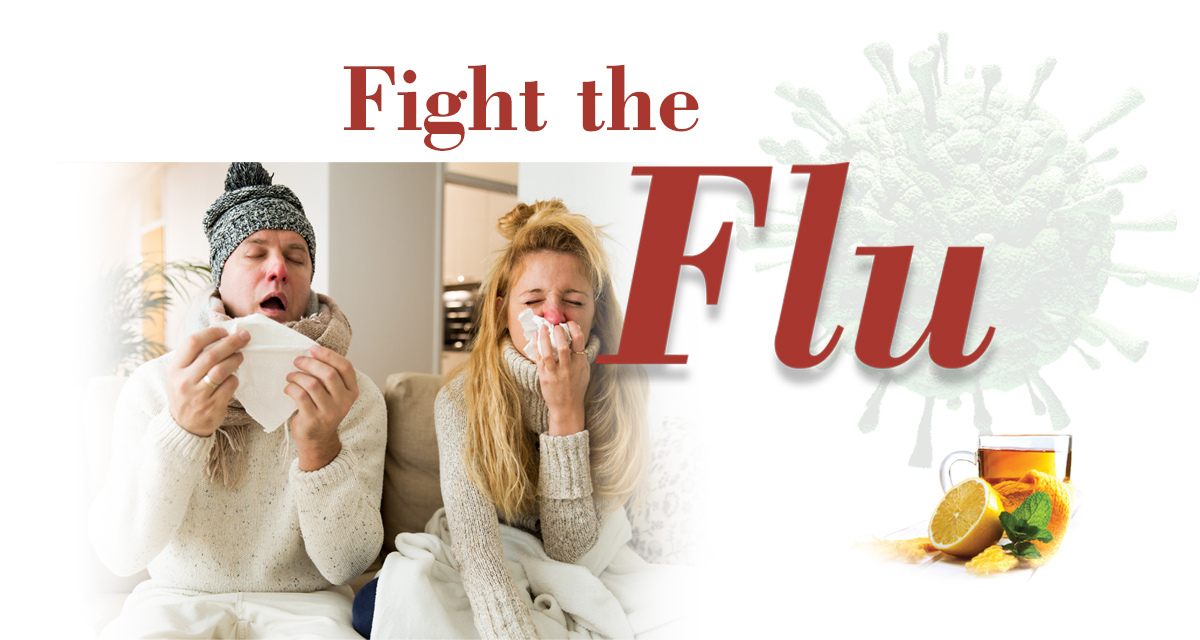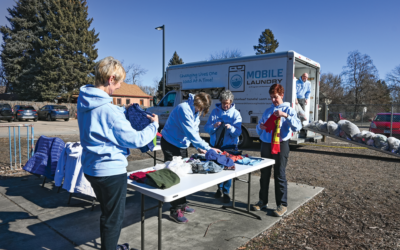By Dan England
Four years ago, Richard Payden’s girlfriend did not mince words. “You look like death,” she told him.
She urged a trip to the emergency room, but Payden knew what he had. He now works as a family physician for UCHealth in Estes Park, and he had seen all the symptoms in dozens of his patients both past and present. He had the flu.
He didn’t brush his girlfriend aside—a wise move, as she is now his wife—but he chose to visit an urgent care instead of the ER. He was healthy, young (he’s now 37) and in good shape. He stayed hydrated and on the couch. But man, he not only looked like death, he felt like it, too. The flu is no joke.
“I was really sick,” he says. Yet last year the flu was an afterthought if we thought about it at all. The coronavirus hogged the spotlight and was such a diva that it probably demanded only green M&Ms in its dressing room.
The flu was such a non-factor last year that Payden recites the statistics with awe: In 2019-20, a record-tying 188 children died from it. One child died from the flu in the country last season. In the 2019-20 season, which runs from October to February, national estimates say the flu sickened 38 million. But public health and clinical labs reported 2,000 cases last season.
“That’s insane,” Payden says. Even when people dismissedCOVID-19, they said it was “no worse than the flu,” making the dethroned king of viruses feel as insignificant as the common cold.
Well, if you come at the king, you best not miss. Payden saw zero cases last year, but he’s expecting a lot more this year, and physicians are expecting many of those cases to be worse than ever.
“Usually in a flu season, there are people with some immunity from last year that carries over,” Payden says. “This season we don’t have that. If it crops up this year, without social distancing and masking, it could theoretically spike, and hospitals are already overwhelmed.”
Deadly serious
Tens of thousands normally die from the flu every year. Nurses and doctors know when the flu is at its worst: The hospitals are usually full.
They’re now full already because of COVID-19, even in Colorado, which has one of the higher vaccination rates in the country.
“There are parts of the country where, to be blunt, if a patient gets sick with COVID-19, they have to wait for someone to die of it before they can get a bed,” Payden says. “There won’t be any beds available for flu patients anywhere.”
The intense but understandable focus on COVID-19 worries doctors because the flu is bad too, and any warnings about it may get buried under another news story about masks in schools.
“One of the concerns about COVID-19 is we forget everything else, right?” says Michael Bradfield, a teaching family physician at family medicine residencies for Banner Health. “I wonder if anyone is tracking anything else, including the flu.”
RSV, a common respiratory virus that usually presents cold-like symptoms but can be serious in compromised patients, older adults and infants, is already here, Bradfield says, which is a good indicator that the flu is on its way.
Doctors are concerned and do believe the flu will hit hard this year, but they also say it’s hard to know just how bad it will be.
“We usually look to Australia for clues,” Bradfield says, “but they’ve had lockdowns, so it’s difficult to predict.”
Masks help, but do we care?
Ah, yes. Lockdowns. Even the word may give you an involuntary shudder, and yet, all those precautions we took were the reason the flu practically disappeared, doctors say. They acknowledge the issue is a political one—just look at the school board meetings full of angry parents because their children have to wear masks—but the numbers are too strong to ignore any correlation. Social distancing definitely helped, and closing schools removed the biggest carrier of the flu, Bradfield says, but masks must have helped as well, in addition to staying at home and increasing hand-washing.
“It’s super interesting because there’s no actual guidelines from the CDC to mask for the flu,” Bradfield says. “We’ve never recommended that over here, but there’s no doubt masking and things like closing down schools took the flu down quite a bit. When you put all those things together, the (low) numbers of flu cases are staggering.”
SUPPORT YOUR IMMUNE SYSTEM
Products love to advertise that they “boost” your immune system, but Dr. Nicole Cotter with UCHealth prefers to use the term “support” when she’s discussing ways to help you fight against the flu or the coronavirus or the host of other illnesses waiting to mess up your life.
“Boosting sounds a little out there,” Cotter says. And it’s problematic to boost an immune system, as there are people who suffer a host of problems because their immune systems are too active: These are generally referred to as autoimmune diseases, and people die long, miserable deaths from them.
But Cotter gets asked about immune systems a lot, as she specializes in integrative medicine, which combines traditional medicine with care that complements or supports it. Mostly, she tells people that health matters.
“The healthiest person can still get COVID-19 and the flu,” Cotter says. “But the chance of you getting the infection or having a poor outcome is going to be less.”
Rather than offer a pill, Cotter offers advice on taking good care of yourself, including getting enough sleep, eating well and being active throughout the day, including exercise.
These all vary from person to person, but there some general guidelines to follow:
 Sleep—Most people need seven to eight hours of sleep a night. “Usually, when you get below six, that can be problematic,” Cotter says.
Sleep—Most people need seven to eight hours of sleep a night. “Usually, when you get below six, that can be problematic,” Cotter says.
 Nutrition—Eating mostly plants, not too much animal protein and avoiding foods that cause inflammation, such as refined sugar and carbs, can help. You should also avoid processed foods and refined cooking oils. “Beyond that, some foods are beneficial to one and not others,” Cotter says. “You may have irritations and things, and the way you figure that out is to listen to your body and its response to certain foods.”
Nutrition—Eating mostly plants, not too much animal protein and avoiding foods that cause inflammation, such as refined sugar and carbs, can help. You should also avoid processed foods and refined cooking oils. “Beyond that, some foods are beneficial to one and not others,” Cotter says. “You may have irritations and things, and the way you figure that out is to listen to your body and its response to certain foods.”
 Exercise—A sedentary lifestyle is bad for many reasons, including it being a major cause of chronic illness, Cotter says. Some handle physical stress better than others, but most physical activity is good for you, if not all of it.
Exercise—A sedentary lifestyle is bad for many reasons, including it being a major cause of chronic illness, Cotter says. Some handle physical stress better than others, but most physical activity is good for you, if not all of it.
 Reduce stress—Exercise can help with this, and so can sleep and a good diet. Finding ways to unwind is important. Seek out counseling if you struggle with your mental health.
Reduce stress—Exercise can help with this, and so can sleep and a good diet. Finding ways to unwind is important. Seek out counseling if you struggle with your mental health.
 Wash your hands—Several times a day, thoroughly, for more than just a few seconds.
Wash your hands—Several times a day, thoroughly, for more than just a few seconds.
Studies do show that masks reduce flu particles, Payden says, and in other countries, residents wore masks for years even before COVID-19 to prevent the spread of flu. Payden did a study abroad program in Japan when he was 17 and was struck by those wearing masks during flu season. He noticed sideways glances and stares if he ever forgot his mask.
“It was socially required of you to put on a mask during flu season,” he says.
Pandemic fatigue may prevent masks from being prevalent again, Payden says. “People are tired of masks and social distancing.”
But it could also be a vast cultural difference between America and Japan. The Japanese tend to put “the group,” meaning society, before themselves, Payden says.
“There are some who are ready for that big of a dynamic change, especially after last year,” he says, “but as for America as a whole, I doubt that it is, as we are a nation born and bred around our freedoms. We just don’t have the same mentality as the Japanese.”
There is also a difference from county to county, and that generally follows politics. Bradfield called Weld County “its own beast” and pointed to a recent Greeley-Evans School District 6 Board meeting to demonstrate: Nearly 25 spoke at the meeting urging board members not to instill a policy mandating masks in schools, even though it wasn’t on the agenda and after the superintendent already instilled a voluntary mask policy in schools.
“People are really opposed to it,” Bradfield says. “The vaccination rates are also low. I don’t think you’d find healthcare professionals who are upset at masking. I think it would help, but people aren’t wearing masks.”
Bradfield did write individually to District6 school board members and asked them to consider their students, as more than 50 percent in the district come from lower-income families. Those families don’t have the same parachutes, as sick leave is tougher to come by and they tend to be more exposed to the illness, such as riding public transportation. Access to healthcare is also tougher for those families. Last year’s breakout in the JBS meatpacking plant, which killed several workers, was an example.
“Flu, just like COVID-19, does disparately affect the underserved,” Bradfield says.
Payden and Bradfield both say the best weapons out there are the vaccinations, both against the flu and against COVID-19. Even if they don’t prevent transmission for everyone, they almost always do prevent serious illness if someone does get it. Flu vaccines aren’t nearly as effective as the COVID-19 vaccines, and yet they may be just as crucial. There are toddlers who haven’t been exposed to the flu at all. There are kids who may get it worse. There are adults who may not have access to treatment even if they get a bad case.
“Please, please get vaccines,” Bradfield says, “and be vigilant about everything else.”
Facts About the Flu
- The traditional season runs from October to February.
- Symptoms include shortness of breath or difficulty breathing, even when you’re walking around; a high heart rate, even when resting; congestion in the chest or nose; fatigue; low oxygen levels; nausea, even to the point of vomiting; headache; body aches and fever.
- A vaccine is available this year. Vaccines tend to be 40-60 percent effective, though they usually prevent serious illness. You should probably wait two weeks before and after receiving the COVID-19 vaccine or a booster shot.
- The flu kills thousands a year, especially those with compromised conditions and the elderly. Infants are also considered a high risk for more serious illness.






